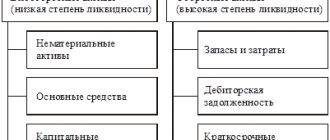Long-term and short-term financial investments
The placement of an organization's free funds for the purpose of subsequent profit in the form of dividends or interest is called financial investments. The investment periods differ between short-term and long-term investments. The latter include objects with a maturity of more than 1 year. What exactly can the company's funds be invested in? The main forms of long-term financial investments include (clause 3 of PBU 19/02):
- State and/or municipal securities.
- Securities of other companies, including bills and bonds with a precisely defined value and maturity date.
- Deposits in banking institutions.
- Contributions to shareholders or share capital of companies; under simple partnership agreements.
- Interest-bearing loans issued to other organizations.
- Accounts receivable under contracts for the assignment of claims.
- Other long-term investments of a similar nature.
Note! Own securities purchased for the purpose of further cancellation or resale are not recognized as financial investments; investments in precious metals; bills of exchange for mutual settlements with counterparties; investments of the organization in property objects used in rental activities (clauses 3, 4 of PBU 19/02).
This line shows information about the organization’s financial investments, the circulation (repayment) period of which exceeds 12 months after the reporting date (clause 19 PBU 4/99, clause 41 of the Accounting Regulations “Accounting for Financial Investments” PBU 19/02, approved by the Order Ministry of Finance of Russia dated December 10, 2002 N 126n).
What is included in financial investments?
An organization's financial investments may include:
— state and municipal securities, securities of other organizations, including debt securities in which the date and cost of repayment are determined (bonds, bills);
— contributions to the authorized (share) capital of other organizations (including subsidiaries and dependent business companies) <*>;
— loans provided to other organizations, deposits in credit institutions;
— receivables acquired on the basis of assignment of the right of claim;
- contributions of a partner organization under a simple partnership agreement, etc.
The amount of funds transferred as a contribution to the authorized capital of another organization, before the state registration of the relevant changes in the constituent documents, is reflected in the balance sheet as financial investments (Appendix to the Letter of the Ministry of Finance of Russia dated 02/06/2015 N 07-04-06/5027).
To include the above-mentioned assets in the organization’s financial investments, the following conditions must be simultaneously met (clauses 2, 3 of PBU 19/02):
— the presence of properly executed documents confirming the existence of the organization’s right to financial investments and to receive funds or other assets arising from this right;
— transition to organizing financial risks associated with financial investments (risk of price changes, risk of debtor insolvency, liquidity risk, etc.);
- the ability to bring economic benefits (income) to the organization in the future in the form of interest, dividends or an increase in their value (in the form of the difference between the sale (redemption) price of a financial investment and its purchase value as a result of its exchange, use in repaying the organization’s obligations, an increase in the current market cost, etc.).
Attention!
Interest-free loans issued by the organization, received from buyers (customers) of goods (works, services), interest-free bills accepted for accounting at face value, as well as similar assets are not financial investments of the organization and are shown on line 1230 “Accounts receivable” in section. II Balance Sheet.
At what cost are financial investments reflected in accounting?
Financial investments are accepted for accounting at their original cost, which is determined in accordance with clauses 9 - 15 of PBU 19/02, clause 13 of PBU 20/03.
- Financial investments for which the current market value is determined (which are traded on the ORS) are reflected in accounting and reporting at the end of the reporting year at the current market value by adjusting their valuation as of the previous reporting date. The organization can make this adjustment monthly or quarterly (clause 20 of PBU 19/02).
For reference: The current market value of securities means...
The current market value of securities is understood as their market price, calculated in the prescribed manner by the organizer of trading on the securities market (paragraph 2 of clause 13 of PBU 19/02).
To determine the current market value of financial investments, all available sources of information on market prices for these financial investments must be used, including data from foreign organized markets or trade organizers (Appendix to the Letter of the Ministry of Finance of Russia dated January 29, 2014 N 07-04-18/01) .
In this case, the cost of securities at which they are reflected in accounting and financial statements is adjusted on reporting dates in accordance with their market price, regardless of the total quantity of these securities that are the subject of transactions, as well as the ratio of the specified quantity to the number of securities , which is owned by the organization (Appendix to the Letter of the Ministry of Finance of Russia dated January 29, 2014 N 07-04-18/01).
Question: In what cases is it permissible not to adjust the value of securities traded on the Ordinary Securities Market in accordance with their market value as of the reporting date?
Answer: 1. Small business organizations, with the exception of issuers of publicly offered securities, have the right to carry out a subsequent assessment of all financial investments, including securities traded on the Ordinary Securities Market, at their original cost (paragraph 2, clause 19, clause 21 of PBU 19 /02). This method of subsequent assessment of financial investments should be enshrined in the accounting policy of a small enterprise and applied sequentially from one reporting year to another (clauses 5, 7 of PBU 1/2008).
From November 16, 2014, simplified methods of accounting, including simplified financial statements, are not allowed to be used by commercial organizations - small businesses, if they are microfinance organizations or if their financial statements are subject to mandatory audit (clause 1, 4 parts. 5, Article 6 of Law No. 402-FZ).
- According to paragraph 36 of PBU 4/99, the rules for assessing individual items of financial statements are established by the relevant accounting provisions. In particular, the rules for evaluating securities traded on the Ordinary Securities Market are provided for in clause 20 of PBU 19/02.
At the same time, the organization has the right to decide to deviate from the rules of PBU 4/99 in exceptional situations (for example, in the case of nationalization of property), when the application of these rules does not allow the generation of financial statements that give a reliable and complete picture of the financial position of the organization, the financial results of its activities and changes in its financial position (paragraph 3, paragraph 6 of PBU 4/99).
To make a decision on the specified derogation, the organization must:
— clearly establish the conditions (circumstances) under which the application of the rules of PBU 4/99 does not allow the formation of financial statements that give a reliable and complete picture of the financial position of the organization, the financial results of its activities and changes in its financial position;
— make sure that the application of rules different from the rules of PBU 4/99 will allow the formation of financial statements that give a reliable and complete picture of the financial position of the organization, the financial results of its activities and changes in its financial position.
Such clarifications are contained in Letters of the Ministry of Finance of Russia dated 02/26/2015 N 07-01-06/9818, dated 02/27/2015 N 07-01-06/9966.
Based on the foregoing, we can conclude that in exceptional cases it is possible to deviate from the requirement of clause 20 of PBU 19/02 on adjusting the value of securities traded on the Ordinary Securities Market in accordance with their market value as of the reporting date, if this requirement is met does not allow the generation of financial statements that provide a reliable and complete picture of the financial position of the organization, the financial results of its activities and changes in its financial position.
For information on the requirements for disclosure in financial statements of information about significant deviations from the rules of PBU 4/99 made by the organization, see Section. 3.5.10 “Other information disclosed in the Explanations to the Balance Sheet and the Statement of Financial Results.”
- Financial investments for which the current market value is not determined (which are not traded on the securities market) are subject to reflection in accounting as of the reporting date at their original cost. For such financial investments, the organization is required to test for impairment and create an impairment reserve.
Question: When is a test for impairment of financial investments carried out?
Answer: An impairment test is carried out at least once a year as of December 31 of the reporting year if there are signs of impairment of financial investments. The organization has the right to carry out this check on the dates of preparation of interim financial statements.
Question: In what cases is a reserve created for the impairment of financial investments?
Answer: If the impairment test confirms a sustained significant decrease in the value of financial investments, the organization creates a reserve for impairment of financial investments in the amount of the difference between the book value and the estimated value of such financial investments (clauses 21, 38 of PBU 19/02). Let us recall that the creation of estimated reserves is considered as a change in estimated values in accordance with paragraphs 2, 3 of PBU 21/2008.
For debt securities for which the current market value is not determined, the initial value may change by increasing (decreasing) it by the difference between the original and nominal value during their circulation period (clause 22 of PBU 19/02).
In which accounting accounts are financial investments reflected?
According to the Instructions for using the Chart of Accounts, financial investments are reflected in the corresponding subaccounts of account 58 “Financial Investments”, analytical accounting for which should also provide information on long-term and short-term assets.
At the same time, the Instructions for the application of the Chart of Accounts stipulate that such financial investments as deposits can be accounted for in account 55 “Special accounts in banks”, subaccount 55-3 “Deposit accounts”, and interest-bearing loans issued to employees of the organization can be reflected in account 73 “Settlements with personnel for other operations”, subaccount 73-1 “Settlements for loans provided”.
FOR MORE on this issue see:
Section “Accounting for financial investments (accounts 58, 59)” of the Guide to IB “Correspondence of accounts”
Section “Accounting for settlements on loans and borrowings in rubles from the lender” of the Guide to Information Security “Correspondence of Accounts”
Section “Accounting for settlements on loans and borrowings in foreign currency from the lender” of the Guide to Information Security “Correspondence of Accounts”
Section “Accounting for settlements on loans in conventional units from the lender” of the Guide to Information Security “Correspondence of Accounts”
Section “Accounting for loans issued by property from the lender” of the Guide to Information Security “Correspondence of Accounts”
Section “Accounting for the termination of an obligation under a loan agreement by compensation, novation, offset from the lender” of the Guide to IB “Correspondence of Accounts”
What accounting data is used when filling out line 1170 “Financial investments”?
Regardless of which accounting account reflects assets that, in accordance with the requirements of PBU 19/02, are financial investments, information about them must be shown in the Balance Sheet as part of financial investments. Line 1170 “Financial investments” of the Balance Sheet indicates the value of long-term financial investments as of the reporting date, as of December 31 of the previous year and as of December 31 of the year preceding the previous one.
For long-term financial investments traded on ORTSB, their current market value is shown (i.e., the initial cost taking into account adjustments) according to analytical accounting data for account 58 (clauses 20, 24 of PBU 19/02).
For long-term financial investments for which the current market value is not determined, their initial value is shown minus the reserve created for them, for which analytical accounting data is used for accounts 58 (55, subaccount 55-3, and 73, subaccount 73-1) and 59 “Provisions for impairment of financial investments” (clauses 24, 38 PBU 19/02, clause 35 PBU 4/99).
Attention!
If significant, the contribution of the partner organization to joint activities is shown in the Balance Sheet as a separate item (clause 16 of PBU 20/03).
Line 1170 “Financial investments” = Debit balance on account 58, subaccounts 55/3 and 73/1 (analytical accounts of long-term financial investments) - Credit balance on account 59 (analytical account for the reserve created for long-term financial investments).
The indicators of line 1170 “Financial investments” as of December 31, 2012 and as of December 31, 2011 are transferred from the Balance Sheet for the previous year.
The “Explanations” column provides an indication of the disclosure of this indicator. If an organization draws up Explanations to the Balance Sheet and the Statement of Financial Results according to the forms contained in the Example of Explanations given in Appendix No. 3 to Order of the Ministry of Finance of Russia No. 66n, then in the column “Explanations” on line 1150 “Financial investments” tables 3.1 and 3.2.
Example of filling out line 1170 “Financial investments”
Indicators for accounts 58, 59 and 73, subaccount 73-1, in accounting (indicators for account 55, subaccount 55-3, absent): rub.
| Index | As of the reporting date (December 31, 2014) |
| 1 | 2 |
| 1. On the debit of account 58, analytical accounts for long-term financial investments | 3 270 000 |
| 2. On the debit of account 73, subaccount 73-1, analytical account for recording long-term interest-bearing loans issued to employees | 130 000 |
| 3. On the credit of account 59, analytical account of the reserve for long-term financial investments | 70 000 |
Fragment of the Balance Sheet for 2013
| Explanations | Indicator name | Code | As of December 31, 2013 | As of December 31, 2012 | As of December 31, 2011 |
| 1 | 2 | 3 | 4 | 5 | 6 |
| 3.1, 3.2 | Financial investments | 1170 | 1080 | 1080 | 560 |
Solution
The cost of the organization’s long-term financial investments minus the created reserve is:
as of December 31, 2014 - RUB 3,330 thousand. (RUB 3,270,000 + RUB 130,000 - RUB 70,000);
as of December 31, 2013 - 1080 thousand rubles;
as of December 31, 2012 - 1080 thousand rubles.
A fragment of the Balance Sheet in Example 1.7 will look like this.
| Explanations | Indicator name | Code | As of December 31, 2014 | As of December 31, 2013 | As of December 31, 2012 |
| 1 | 2 | 3 | 4 | 5 | 6 |
| 3.1, 3.2 | Financial investments | 1170 | 3330 | 1080 | 1080 |
Accounting for long-term investments and financial investments
Accounting for long-term and short-term financial investments is carried out on the account. 58 in the manner prescribed by Order of the Ministry of Finance No. 94n dated October 31, 2000. Information on invested funds with the opening of the corresponding sub-accounts is summarized here. Analytical accounting of long-term financial investments is carried out by type of investment, counterparties, and terms.
Subaccounts to the account 58:
- 58.1 – records of shares and shares are kept here.
- 58.2 - to display transactions on investments in securities - both public and private.
- 58.3 – loans provided to other enterprises (individual entrepreneurs, individuals) – cash and others – are taken into account here.
- 58.4 – intended to display contributions based on simple partnership agreements.
Note! Currently, for the correct accounting of long-term financial investments, account 06 of the same name is no longer used. According to Order No. 94n, this account was excluded from the current Chart of Accounts of enterprises and was replaced by an account. 58.
Accounting of financial investments.
Financial investments in accounting are accounted for in account 58 “Financial investments”. The financial investment account is Active. That is, an increase in assets by debit is reflected by a decrease in credit. In accordance with the instructions for using the chart of accounts, sub-accounts can be opened for account 58:
-58/1 “Units and shares”;
-58/2 “Debt securities”;
-58/3 “Loans provided”;
-58/4 “Deposits under a simple partnership agreement”
Consider the following examples:
- Accounting for deposits.
- Accounting for the purchase of shares.
- Accounting for adjustments to financial investments (shares for which the market price is determined).
- Accounting for adjustments to bonds (for which the market price is not determined).
- Accounting for contributions to the authorized capital.
- Creation of a reserve for depreciation of securities.
1) Accounting for deposits.
Let's look at the transactions for accounting for deposits:
- Debit 55/3 (58/Deposit) Credit 51 - 50,000 rubles. - A deposit has been opened in the bank.
- Debit 76 Credit 91/Income - 15,000 rubles - Interest accrued on the deposit.
- Debit 51 Credit 58/Deposit - Funds from the deposit were returned.
- Debit 51 Credit 76-15,000 rubles - Interest received on the current account.
Comments: Deposits can be taken into account in both account 55 and account 58.
2) Accounting for the purchase of shares.
Let's look at the entries for accounting for the purchase of shares:
- Debit 58/Shares Credit 76/Seller-10,000 rubles.- Shares purchased.
- Debit 58/Shares Credit 76/Intermediary 1-5000 rubles - Intermediary services are reflected.
- Debit 58/Shares Credit 76/Intermediary2-1500 rubles -Reflects the services of intermediary 2.
- Debit 76/(Seller, intermediary1,2) Credit 51-16500 rubles (10,000+5000+1500) - Paid through a bank account to the seller and intermediaries.
Comments: 16,500 rubles (10,000+5000+1500) will be called the initial cost.
3) Accounting for adjustments to financial investments (shares for which the market price is determined).
Problem conditions:
01/01/2018 DaxNet CJSC bought 10 shares for 3,000 rubles.
These shares are traded on the securities market.
As of May 1, 2019, the price of shares was 3,200 rubles per share.
Let's make the wiring:
- Debit 76 Credit 51-30,000 rubles (10*3000) - Paid for shares.
- Debit 58 Credit 76-30,000 rubles. - Shares accepted as financial investments.
- Debit 58 Credit 91-2,000 rubles. ((3200-3000)*10) - Share price adjusted.
4) Accounting for adjustments to bonds (for which the market price is not determined).
Conditions of the problem:
01/01/2019 JSC "Tredax" bought 100 bonds at a price of 10,000 rubles.
Nominal value 12,000 rubles.
Quarterly income 5%.
CJSC "Tredax" will adjust the initial cost to the nominal value for 4 quarters.
Solution to the problem (wiring):
- Debit 76 Credit 51- 1,000,000 rubles. (100*10000) - Bonds purchased, paid.
- Debit 58 Credit 76-1,000,000 rubles - Bonds accepted as Finnish. investments.
- Debit 76 Credit 91-60,000 rubles. (12000*100*0.05) - Interest accrued on the bond.
- * Debit 58 Credit 91-50,000 rubles. ((12000-10000)*100)/4 - 1/4 of the difference between the initial and par value of the bonds is taken into account
*-Such posting will be carried out 3 times at the end of the quarter.
5) Accounting for contributions to the authorized capital.
Making a contribution to the authorized capital of the transaction:
- Debit 76 Credit 51-100,000 rubles - Money transferred as a contribution to the authorized capital.
- Debit 58 Credit 76-100,000 rubles. - The deposit is reflected as financial. investments.
If a company invests property in its authorized capital, then the postings will be slightly different (since there is an agreed upon value of the property valuation contribution and the actual price recorded in the property accounting account)
- Debit 76 Credit 43.10 - 10,000 rubles. - The book value of the property was written off as a contribution to the authorized capital of another organization.
- Debit 76 Credit 01/09-25,000 rubles. -The residual value of the fixed asset transferred as a contribution to the authorized capital has been written off.
- Debit 58 Credit 76-40,000 rubles. (10,000+25,000+Difference) - The contribution to the authorized capital is reflected as part of financial investments, at an agreed price with the founders, in the constituent agreement.
- Debit 76 Credit 91/Income - 5000 rubles (40000-25000-10000) - The difference in price between the contract price and the book value of the assets that were contributed to the authorized capital is reflected. In this case, as income, since the valuation of the contribution is greater than the actual value of the contributed assets.
- Debit 91/Expense Credit 76-?, If the value (balance sheet) had been added. agreed value of the deposit. There would be other expenses.
Long-term financial investments - an asset or a liability?
Account 58 is active. The debit reflects the actual investments of the enterprise in correspondence with the accounts of valuables. For example, this is an account. 51, 50, 52, 01, 10, 91, 75, 80, 76, 98. Accordingly, the disposal of investments when the debtor repays obligations is reflected in the loan account. 58 in correspondence with property or other accounts. These are accounts such as - 52, 50, 51, 76, 90, 80, 91, 99, 04, 01.
Note! The procedure for accepting financial investments for accounting is given in clauses 8-17, 18-24 PBU 19/02; upon disposal, you must follow the requirements of clauses 25-33 of the PBU.
Investments in the authorized capital of another organization
Only by purchasing shares can you make a contribution to the authorized capital of another organization, but you can pay for the shares themselves both in money and in the available property equivalent. To account for financial investments represented by contributions to the authorized capital of a joint-stock company, they are kept on account 58, while subaccount 1 is used. They are reflected as a debit to account 58/1 in correspondence with cash accounts. Costs incurred when purchasing shares are initially recorded in account 08 “Capital Investments”, and from it the actual cost of shares is written off to the debit of accounts 06 or 58.
If property is used for calculation, their value is assessed on a contractual basis and is reflected in the credit of accounts 90 “Sales” and 91 “Other income and expenses” and the debit of the same accounts: for fixed assets and intangible assets - at the residual value, and for goods and finished products - and at actual cost. When replenishing the authorized capital of an organization with the help of tangible assets, the tax on accrued income is 6%.
Long-term financial investments on the balance sheet
Regardless of the type of investment, long-term financial investments in the balance sheet are line 1170. Information about the balances at the end of the reporting period for issued interest-bearing loans, purchased securities, deposits, contributions to share capital, charter capital and other investment objects with a validity period of more than 12 months Financial investments of a short-term nature, that is, with a repayment (circulation) period of less than a year, must be reflected on line 1240, excluding cash equivalents.
Note! If an enterprise creates a reserve for the depreciation of the value of investments, the value indicator minus the amount of deductions to the reserve is entered on line 1170.
Analysis of long-term financial investments
In order to improve the efficiency of managing an enterprise's available funds, it is necessary to analyze financial investments. The procedure may include a multifactor analysis of the composition and horizontal structure of investments; long-term calculation of investment results; choosing the most profitable direction, etc. At the same time, an increase in long-term financial investments indicates that the company has a significant amount of available funds that can be used for long-term investment.
On the one hand, this indicates the success of the business. But on the other hand, it is fraught with a decrease in business activity in the main work activity, which in the future may cause a decrease in profits for the reporting period. Therefore, it is optimal to analyze indicators over time, and not just over a short period of time.







